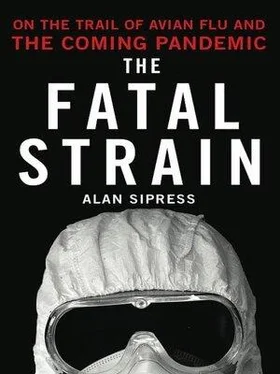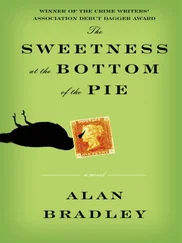165 “Usually, with other infectious diseases”:Mary Ann Benitez, “Health Chief Told Outbreak a State Secret,” South China Morning Post, Jan. 13, 2004.
165 She was faulted:Report of the Select Committee to Inquire into the Handling of the Severe Acute Respiratory Syndrome Outbreak by the Government and the Hospital Authority, Hong Kong Legislative Council, July 2004, ch. 3, www.legco.gov.hk/yr03-04/english/sc/sc_sars/reports/sars_rpt.htm(accessed Feb. 16, 2009).
165 a forty-four-year-old seafood seller: SARS: How a Global Epidemic Was Stopped (Manila: WHO Western Pacific Regional Office, 2006), ch. 13.
166 ninth floor of the Metropole:For an excellent account of the Metropole episode, see Ellen Nakashima, “SARS Signals Missed in Hong Kong,” Washington Post, May 20, 2003. See also SARS: How a Global Epidemic Was Stopped, ch. 14.
168 Air China flight 112: SARS: How a Global Epidemic Was Stopped, ch. 15; Brad Evenson, “‘Viral Bullets’: SARS ‘Super Spreader’ Seemed to Infect All Those Around Him on Air China Flight 112,” National Post, Mar. 29, 2003; Joseph Kahn with Elisabeth Rosenthal, “Even in Remote China, SARS Arrives in Force,” New York Times, Apr. 22, 2003; and Indira A. R. Lakshmanan, “Health Experts Express Alarm at Nature of SARS Spread on Air China Flight,” Boston Globe, May 18, 2003.
168 more than 4,000:Ellen Nakashima, “SARS Signals Missed in Hong Kong,” Washington Post, May 20, 2003.
169 islanders of the Pacific:Alfred W. Crosby, America’s Forgotten Pandemic: The Influenza of 1918, 2nd ed. (New York: Cambridge University Press, 2003), ch. 12.
169 Eskimo villages of Alaska:John M. Barry, The Great Influenza: The Epic Story of the Deadliest Plague in History (New York: Viking Penguin, 2004), ch. 30; Gina Kolata, Flu: The Story of the Great Influenza Pandemic of 1918 and the Search for the Virus That Caused It (New York: Simon & Schuster, 1999), ch. 4; and Crosby, America’s Forgotten Pandemic, ch. 12.
170 threat of infectious disease:For a discussion of the positive and negative implications of globalization for infectious disease, see Karen J. Monaghan, “SARS: Down But Still a Threat,” National Intelligence Council, 2003, reprinted in Stacey Knobler et al., eds., Learning from SARS: Preparing for the Next Disease Outbreak—Workshop Summary (Washington: National Academies Press, 2004).
170 speed of jet aircraft:John T. Bowen Jr. and Christian Laroe, “Airline Networks and the International Diffusion of Severe Acute Respiratory Disease, SARS,” Geographical Journal 172, no. 2 (June 2006): 130-44.
170 “real potential for rapid dissemination”:Statement of Mark A. Gendreau before the Committee on House Transportation and Infrastructure Subcommittee on Aviation, Apr. 6, 2005, Congressional Quarterly: Congressional Testimony, Apr. 6, 2005.
170 “a wake-up call”:WHO news release, International Health Regulations Enter into Force, June 14, 2006.
170 The Black Death:David Herlihy, The Black Death and the Transformation of the West (Cambridge, MA: Harvard University Press, 1997).
170 The last of three cholera epidemics:G. F. Pyle, “The Diffusion of Cholera in the United States in the Nineteenth Century,” Geographical Analysis 1 (1969): 59-75.
170-71 Using data on the volume of travelers:Rebecca F. Grais, Hugh Ellis, and Gregory E. Glass, “Assessing the Impact of Airline Travel on the Geographic Spread of Pandemic Influenza,” European Journal of Epidemiology 18 (2003): 1065-72.
171 a different statistical approach:Ben S. Cooper et al., “Delaying the International Spread of Pandemic Influenza,” PLoS Medicine 3, no. 6 (June 2006): e212.
171 isolated a pathogen:J. S. Malik Peiris et al., “Coronavirus as a Possible Cause of Severe Acute Respiratory Syndrome,” Lancet 361, no. 9366 (Apr. 19, 2003): 1319-25.
172 an unprecedented coup:For a fuller discussion of WHO’s success, see J. S. Mackenzie et al., “The WHO Response to SARS and Preparations for the Future,” in Stacey Knobler et al., eds., Learning from SARS: Preparing for the Next Disease Outbreak—Workshop Summary (Washington: National Academies Press, 2004); David L. Heymann and Guenael Rodier, “SARS: Lessons from a New Disease,” in Knobler, Learning from SARS; and SARS: How a Global Epidemic Was Stopped (Manila: WHO Western Pacific Regional Office, 2006), ch. 2.
172 “The quality, speed and effectiveness”:Knobler, Learning from SARS, 2.
174 approached the traders:For a dramatic account, see Karl Taro Greenfeld, China Syndrome (New York: HarperCollins, 2006), ch. 69.
175 found the evidence:Yi Guan et al., “Isolation and Characterization of Viruses Related to the SARS Coronavirus from Animals in Southern China,” Science 302, no. 5643 (Oct. 10, 2003): 276-78. For a discussion of Guan’s investigation, see Dennis Normile and Martin Enserink, “Tracking the Roots of a Killer,” Science 301, no. 5631 (July 18, 2003): 297-99.
176 “first emerging disease”: SARS: How a Global Epidemic Was Stopped , overview.
177 its reproductive number was lower:Marc Lipsitch et al., “Transmission Dynamics and Control of Severe Acute Respiratory Syndrome,” Science 300, no. 5627 (June 20, 2003): 1966-70.
177 three times greater or more:Christophe Fraser et al., “Factors That Make an Infectious Disease Outbreak Controllable,” PNAS 101, no. 16 (Apr. 20, 2004): 6146-51.
177 virus in their nose and throat:J. S. Malik Peiris et al., “Clinical Progression and Viral Load in a Community Outbreak of Coronavirus -Associated SARS Pneumonia: A Progressive Study,” Lancet 361, no. 9371 (May 24, 2003): 1767-72.
177 rarely contagious in the first few days:Roy M. Anderson et al., “Epidemiology, Transmission Dynamics and Control of SARS: The 2002-2003 Epidemic,” Philosophical Transactions of the Royal Society of London B: Biological Sciences 359 (2004): 1091-1105; and Lipsitch, “Transmission Dynamics.”
177 “very lucky this time”:Anderson, “Epidemiology, Transmission Dynamics and Control of SARS.”
177 between 30 and 50 percent:Fraser, “Factors That Make an Infectious Disease Outbreak Controllable.”
177 “Once adapted to human-to-human transmission”:J. S. Malik Peiris and Yi Guan, “Confronting SARS: A View from Hong Kong,” Philosophical Transactions of the Royal Society of London B: Biological Sciences 359 (2004): 1075-79.
Chapter Seven: Cockfighting and Karma
188 about 7,500 years:Barbara West and Ben-Xiong Zhou, “Did Chickens Go North? New Evidence for Domestication,” Journal of Archaeological Science 15 (1988): 515-33.
188 most likely in Thailand itself:Akishinonomiya Fumihito et al., “One Subspecies of the Red Junglefowl ( Gallus gallus gallus ) Suffices as the Matriarchic Ancestor of All Domestic Breeds,” PNAS 91 (Dec. 1994), 12505-9.
188 red jungle fowl:Ibid.
189 “fight for kingdoms”:“Commemoration of King Naresuan: The Nation’s Great King 400 Years Ago,” Welcome to Chiangmai and Chiangrai, n.d., www.chiangmai-chiangrai.com/king_n.html(accessed Feb. 16, 2009).
Читать дальше











